Physical Address
304 North Cardinal St.
Dorchester Center, MA 02124
Physical Address
304 North Cardinal St.
Dorchester Center, MA 02124
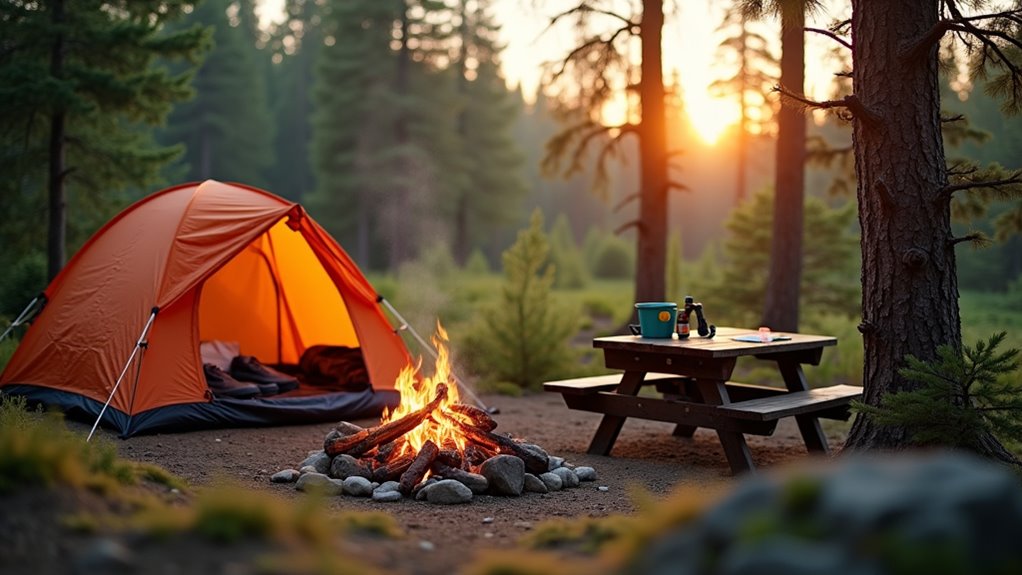
Outdoor adventures hide unexpected dangers that even experienced campers overlook—discover the 14 critical threats that could turn your trip deadly.
When you’re “getting back to nature,” you’re actually entering an environment where Mother Nature doesn’t always play nice. Sure, camping offers incredible experiences and memories that’ll last a lifetime, but it also presents real dangers that can turn your peaceful getaway into a nightmare scenario. From silent threats you can’t see to obvious hazards you might overlook, there are fourteen critical safety concerns that could make or break your outdoor adventure—and some might surprise you.
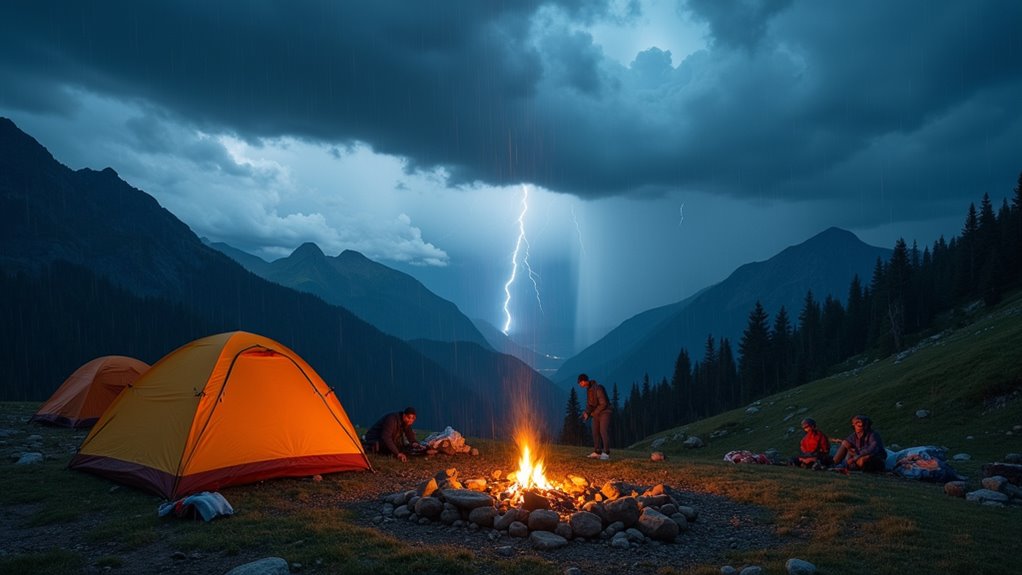
When you’re planning your camping adventure, you’ll want to remember that Mother Nature doesn’t always stick to the weather forecast. Mountain weather can shift from sunny to stormy within minutes, catching unprepared campers off guard. Always pack layers and waterproof gear, even if conditions look perfect.
Mountain weather changes faster than you can pitch a tent, so pack for every possibility.
Watch for sudden temperature drops that can lead to hypothermia, especially at higher elevations where nights turn surprisingly cold.
Lightning storms pose serious threats in open areas, so avoid tall trees and metal objects.
Flash floods can transform peaceful creek beds into dangerous torrents, particularly in desert regions.
Check multiple weather sources before departing and monitor conditions throughout your trip.
Carry emergency shelter like a space blanket, and don’t hesitate to cut your trip short if severe weather approaches.
Plus, consider that certain weather conditions can increase insect activity, making bug prevention strategies essential for maintaining comfort during unexpected weather changes.
While severe weather presents one set of challenges, sharing the wilderness with its native inhabitants requires a completely different approach to safety. You’re entering their home, so respect and preparation are essential.
Essential Wildlife Safety Protocols:
Many campers combine their wilderness adventures with rock climbing, which requires additional awareness of wildlife in vertical environments where escape routes may be limited.
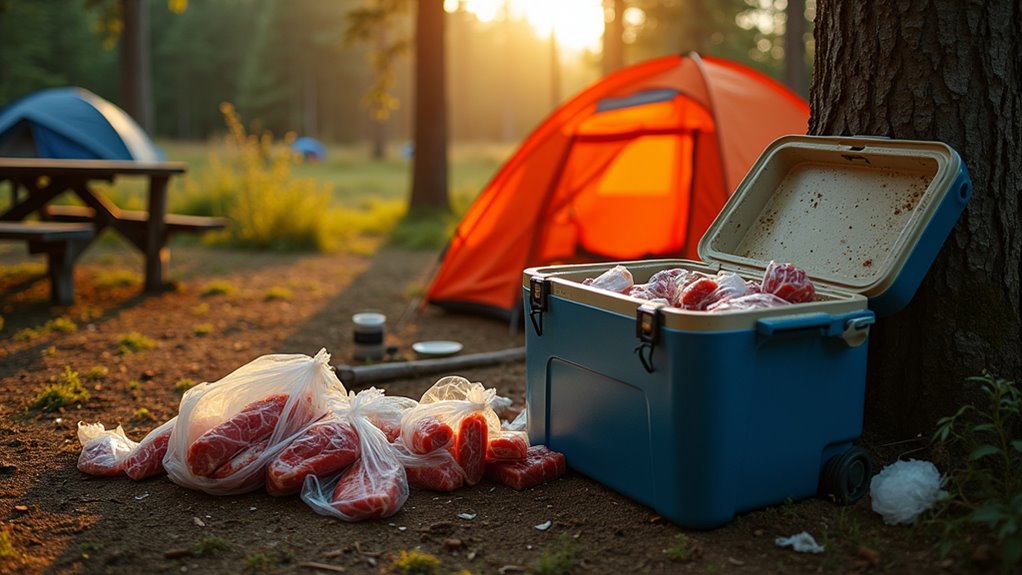
Beyond attracting unwanted wildlife visitors, improper food handling creates serious health risks that can turn your outdoor adventure into a medical emergency. You’re dealing with limited refrigeration, fluctuating temperatures, and basic cooking equipment—perfect conditions for foodborne illness.
Keep perishables in coolers below 40°F, using separate ice for drinks and food. Don’t let raw meat juices contaminate other items. Cook meat thoroughly, especially chicken and ground beef, since you can’t visually confirm doneness around a campfire.
Wash hands frequently, even when water’s scarce—use sanitizer as backup. Store leftovers properly or discard them quickly; the “when in doubt, throw it out” rule becomes critical outdoors where medical help isn’t immediately available.
Consider RV camping as an alternative that provides reliable refrigeration and proper cooking facilities while still allowing you to experience nature comfortably.
Although campfires create memorable moments and provide essential warmth, they’re also one of the leading causes of wildfire disasters that destroy thousands of acres annually. You’ve got the power to prevent catastrophic fires by following proper campfire protocols.
Every camper holds the responsibility to protect our forests from devastating wildfires through simple yet crucial fire safety practices.
Before lighting anything, check local fire restrictions and weather conditions. Wind can turn a cozy campfire into a raging inferno within minutes.
Remember that safe campfire practices are essential every time you head outdoors, as they protect both you and the environment from preventable disasters.

Clean-looking water from streams, lakes, and springs can harbor dangerous microorganisms that’ll turn your camping adventure into a medical nightmare. Giardia, E. coli, and cryptosporidium are common culprits that cause severe diarrhea, vomiting, and dehydration.
Always purify water before drinking. Boiling for one minute kills most pathogens, while water purification tablets or portable filters provide convenient alternatives.
Pack more water than you think you’ll need—dehydration happens faster outdoors, especially at higher altitudes.
Watch for early dehydration signs: headache, dizziness, dark urine, and fatigue. Don’t wait until you’re thirsty to drink water. Electrolyte replacement becomes vital during hot weather or strenuous activities.
Avoid drinking directly from natural sources, even if locals claim it’s safe. Your digestive system isn’t adapted to regional bacteria that don’t affect them.
Understanding the critical role of water conservation becomes essential when planning for extended outdoor adventures where reliable sources may be scarce.
When you’re surrounded by towering trees or endless desert terrain, even experienced hikers can lose their bearings faster than they’d expect. Nature doesn’t care about your GPS signal or smartphone battery, and panic sets in quickly when familiar landmarks disappear.
Here’s what’ll keep you on track:
While navigating through dense vegetation, remember that tick prevention becomes crucial as you brush against tall grass and low shrubs where these parasites commonly wait for hosts.
Your safety depends on preparation, not luck.
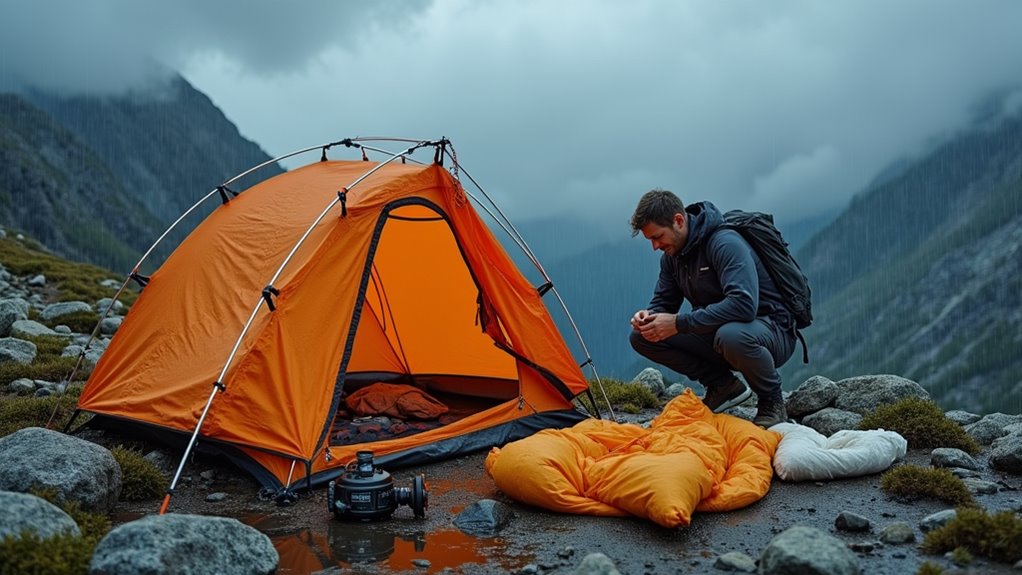
Navigation failures aren’t the only thing that can turn your peaceful camping trip into a survival situation. Your gear can fail when you need it most, leaving you vulnerable to the elements. That expensive tent might develop a tear during a storm, or your sleeping bag’s zipper could jam in freezing temperatures.
Stoves malfunction, water filters break, and headlamps die at the worst moments.
Always pack backup essentials: extra batteries, duct tape for quick repairs, and a backup cooking method. Test your gear before leaving home – don’t discover problems in the wilderness. Carry a basic repair kit with patches, zip ties, and a multi-tool.
Quality gear costs more upfront but reduces failure rates considerably. Remember, redundancy saves lives. Before heading out, review essential camping tips to ensure you’re properly prepared for potential equipment failures.
While equipment failures can strand you, your body’s temperature regulation system poses an even deadlier threat in the backcountry. Hypothermia kills faster than most camping hazards, and it’s sneaky—you won’t realize you’re losing critical thinking abilities until it’s too late.
Temperature-related illnesses don’t discriminate. They’ll strike experienced hikers who underestimate conditions or beginners who overpack cotton clothing. Here’s what you need to know:
Your core temperature dropping just two degrees triggers hypothermia’s deadly cascade. On the opposite end of the spectrum, hot-weather camping requires equally vigilant preparation to prevent heat exhaustion and dehydration.
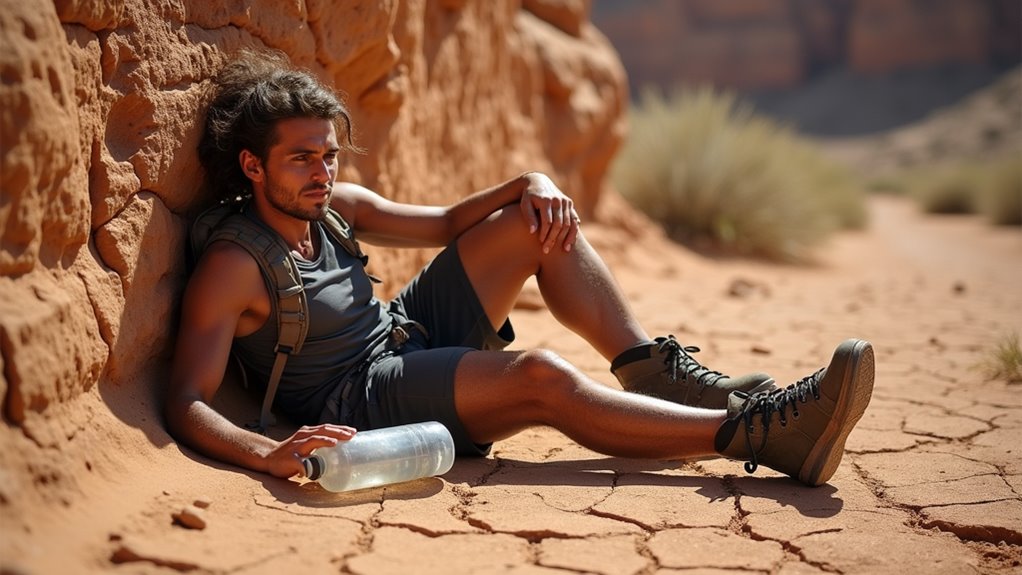
On the flip side of the temperature spectrum, your body’s cooling system can fail just as catastrophically in hot conditions. Dehydration sneaks up faster than you’d think – especially when you’re distracted by setting up camp or hiking trails.
You’ll lose electrolytes through sweat, making plain water insufficient for recovery.
Heat exhaustion presents as heavy sweating, weakness, and nausea.
Heat stroke’s the dangerous escalation: your sweating stops, skin becomes hot and dry, and confusion sets in. That’s a medical emergency requiring immediate cooling and evacuation.
Prevention’s straightforward: drink before you’re thirsty, seek shade during peak sun hours, and wear light-colored, loose clothing. Pack electrolyte supplements and know your limits – machismo won’t help when you’re collapsed beside your tent. High-altitude environments like the Andes present additional dehydration challenges due to increased sun exposure and thinner air that accelerates moisture loss.
Though you might assume you’d recognize dangerous plants from childhood warnings, the wilderness contains dozens of species that can ruin your trip – or worse. Beyond the classic “leaves of three, let it be” poison ivy rule, you’ll encounter regional hazards that demand respect and preparation.
Wilderness hiking exposes you to regional plant hazards that childhood warnings never covered, demanding serious preparation and respect.
Key plants to avoid:
Research your camping area’s specific vegetation hazards beforehand.
Wear long pants when hiking, wash hands frequently, and never burn unknown plants – the smoke can cause respiratory irritation.

Even experienced hikers can find themselves in dangerous situations when the ground beneath their feet becomes unreliable. You’ll need to watch for loose rocks, especially on steep slopes where they can trigger dangerous slides. Muddy trails after rain become slippery hazards that’ll send you tumbling if you’re not careful.
Test suspicious ground with your hiking pole before putting your full weight down. Avoid camping near cliff edges, riverbanks, or anywhere erosion’s clearly active. Snow-covered terrain‘s particularly tricky since it can hide holes, streams, or unstable surfaces underneath.
Rocky areas with scree require deliberate, controlled movements. Don’t rush across questionable terrain just because daylight’s fading. It’s better to backtrack and find safer ground than risk injury in remote locations where help’s hours away.
When planning extended backpacking trips, you’ll encounter more varied terrain conditions over multiple days, making it crucial to assess ground stability continuously as weather and environmental factors change throughout your journey.
While you’re focused on keeping warm and cooking meals, that innocent-looking camping stove can become a silent killer if you’re not careful about ventilation. Carbon monoxide is colorless and odorless, making it virtually impossible to detect without proper equipment.
Never use camping stoves inside your tent or enclosed shelter. Even “well-ventilated” spaces can trap deadly gases.
What seems like adequate ventilation indoors can still allow carbon monoxide to accumulate to lethal levels.
Here’s how to stay safe:
Your morning coffee isn’t worth risking everything.
Proper cooking techniques not only ensure delicious meals but also contribute to overall safety around your campsite.
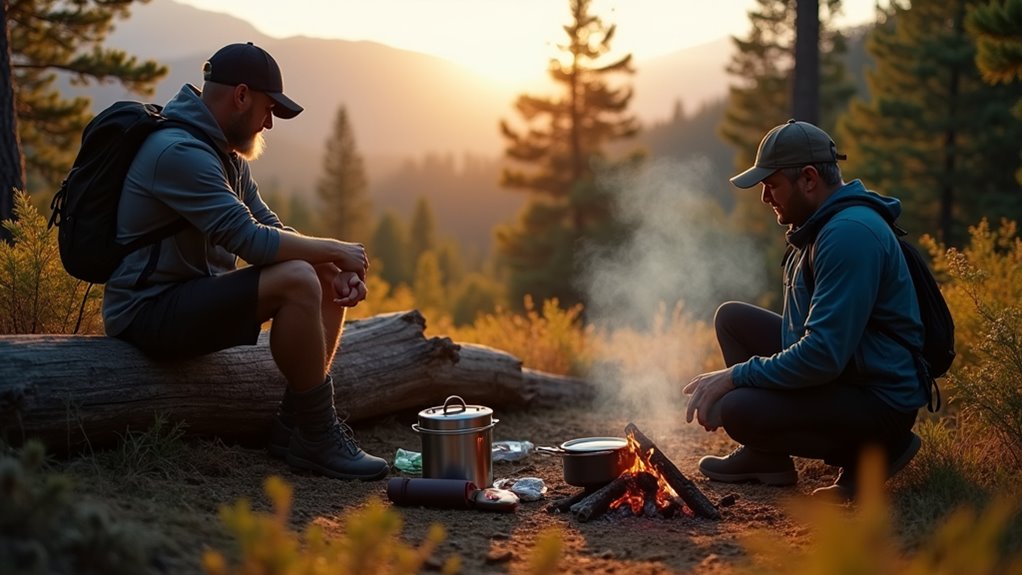
Sharp knives, hot cookware, and uneven terrain create a perfect storm for injuries when you’re miles from the nearest hospital. Pack a complete first aid kit with bandages, antiseptic wipes, burn gel, and pain relievers.
Keep knives sharp—dull blades require more pressure and slip easily. Always cut away from your body and use a stable cutting surface.
For burns, immediately run cold water over the area for 10-15 minutes, then apply burn gel. Don’t use ice or butter—these worsen tissue damage.
Clean cuts thoroughly and apply pressure to stop bleeding before bandaging.
Know your evacuation plan before emergencies strike. Download offline maps and identify the fastest route to medical facilities.
Consider wilderness first aid training—it’s invaluable when you’re your own first responder.
Following proper camping safety guidelines can prevent many of these injuries from occurring in the first place.
When cell towers disappear behind mountain ranges and GPS signals weaken under dense canopy, you’ll need backup communication methods that don’t rely on cellular networks.
Smart campers carry multiple communication options because wilderness emergencies don’t wait for perfect signal conditions. Your backup plan should include:
Always inform someone reliable about your exact route, expected return time, and when to call authorities if you don’t check in. Whether you’re exploring Minnesota’s vast wilderness areas or engaging in exciting activities during your camping trip, having proper emergency communication equipment can be the difference between a minor inconvenience and a life-threatening situation.
You’ve now got the essential safety knowledge under your belt, but remember—preparation is your lifeline in the wilderness. Don’t let overconfidence cloud your judgment when you’re miles from help. Double-check your gear, trust your instincts, and always have a backup plan. The outdoors can be unforgiving, but with these precautions, you’ll create memories instead of emergencies. Stay alert, stay prepared, and enjoy nature’s beauty while respecting its power.